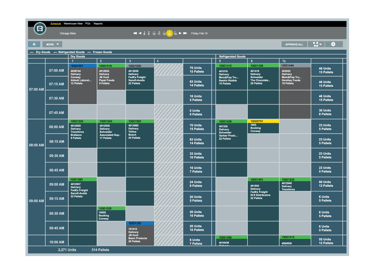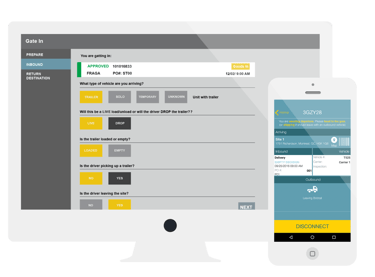These 5 Powerful Yard Management Features Drive Real ROI

Introduction
If you're in the logistics game, you already know that keeping track of trailers, managing drivers, and avoiding gate congestion can feel like a never-ending battle. And when things don’t run smoothly, it doesn’t just cause headaches—it hits your bottom line. So, if you’re dealing with misplaced trailers, delays at the gate, or constantly paying those frustrating detention fees, it's probably time to consider a Yard Management System (YMS).
But here’s the thing—yard management software isn’t just about solving problems; it’s about transforming your yard into a well-oiled machine. The right system gives you real-time control over every part of your operation, making everything from tracking trailers to optimizing driver tasks smoother and faster.
In this blog, we’re diving into the 5 must-have features that every yard management system should have. These features will save you time, cut costs, and make your yard run more efficiently than ever before. Ready to take your yard from chaos to calm? Let’s get into it.
Why Yard Management Software Matters?
Let’s be honest—managing a yard can feel like trying to juggle a dozen things at once. Without the right tools in place, small issues can snowball into major disruptions. Whether it’s lost trailers, slow-moving gate operations, or miscommunication between teams, these problems create delays, increase costs, and hurt your business.
That’s where yard management software comes in. With yard automation on your side, you can take control of everything in real time. No more guessing where trailers are, wondering why drivers are idle, or stressing about congestion at the gate. A solid yard management system will help you:
- Track your trailers, trucks, and drivers in real-time
- Optimize yard driver tasks to boost efficiency
- Manage dock scheduling and gatehouse operations smoothly
- Integrate everything with your Warehouse Management System (WMS) and Transportation Management System (TMS) for seamless communication
At the end of the day, yard management software isn’t just about making things easier. It’s about turning your yard into a powerhouse of productivity.
5 Must Have Features in a YMS
1 - Real Time Visibility on Yard Assets
Picture this: trailers moving in and out, drivers busy with tasks, and your yard humming along smoothly—because you know exactly where everything is at all times. That’s the beauty of real-time visibility, and it’s the first must-have feature of any good yard management software.
When your YMS shows you the location of every trailer, yard truck, and driver in real time, you eliminate guesswork. You know where trailers are parked, whether they’re loaded or empty, and how many are available for shipping. You can even track the status of yard trucks and drivers, ensuring everyone is working on the right tasks at the right time.
And if you work with third-party carriers, having a web portal that shows them where their trailers are parked is a game-changer. No more phone calls asking, “Where’s my trailer?” This level of visibility also reduces detention fees and improves asset utilization.
Pro tip: Go for a YMS that integrates with your WMS or TMS to keep everything in sync and streamline your entire operation.
2 - Yard Driver Task Optimization
Let’s talk about the yard drivers. They’re a critical part of your operation, and if they’re not working efficiently, your yard slows down. That’s why yard driver task optimization is the second feature you need.
A smart yard management system ensures your drivers aren’t wasting time or making unnecessary trips. Instead, the system sends out optimized tasks based on real-time priorities, making sure drivers are always working on what’s most important.
Imagine this: instead of having a driver move one trailer at a time, your YMS combines multiple move requests, optimizing each trip to make the best use of your drivers’ time. It’s not just about getting trailers moved—it’s about getting them moved faster, with fewer resources.
Plus, when drivers are connected via mobile devices, they get real-time updates and tasks, keeping everything flowing smoothly without the need for constant check-ins.
Pro tip: Choose a YMS that can tailor task optimization to your specific needs. That way, whether you’re managing live loads, drops, or a mix of both, you’re always running efficiently.
3 - Dock Scheduling

Ever had trailers piling up, waiting for dock space? Yeah, not fun. That’s why dock scheduling is the third must-have feature in your yard management software.
A YMS that includes dock scheduling allows you to plan and manage the flow of trailers to and from your docks. This ensures that your docks aren’t overwhelmed, and trailers are processed in a smooth and orderly way.
By scheduling live inbound and outbound loads, you get control over your yard’s traffic flow. And with the right scheduling tools, you can even plan trailer moves during downtime, keeping your yard drivers busy without adding to the chaos.
The result? Less congestion, fewer delays, and a more efficient yard overall.
Pro tip: Look for yard management software that integrates dock scheduling with your WMS and TMS. This way, you have full visibility of what’s coming in and out, and you can plan yard operations more effectively.
4 - Gatehouse Management

The gatehouse is the first point of contact for your drivers—and often the source of many yard bottlenecks. A good yard management system will have gatehouse management built in to speed up this process and keep things secure.
With yard automation, gate guards can see real-time data about who’s arriving, why they’re there, and where they need to go. This makes checking in faster and more accurate, so drivers spend less time waiting at the gate and more time getting things done.
If your yard handles a lot of traffic, consider self-service kiosks for drivers to check in themselves. This will cut down on the lines at the gate and get trailers moving more quickly. Plus, enhanced gatehouse management improves security, so you always know who’s entering and leaving your yard.
Pro tip: For yards with high traffic, look for a YMS that can integrate with automated vehicle access systems. These systems can read license plates and automatically grant access, speeding things up even more.
5 - Integration to External Systems
If you wish to leverage the fundamental benefits of a YMS, then you should consider sending and receiving data electronically with your other informations systems. Integration to a TMS or a WMS will eliminate duplicate data entry and maintain continuity between systems.
Furthermore, you can consider Integrating to vehicle telematics systems; allowing your operation to leverage vehicle position data within the yard. A yard management system should utilize standard methods such as web services, allowing for the greatest flexibility and fluidity of information between your systems.
Here’s the thing—your YMS is only as good as its ability to work with the rest of your systems. That’s why integration is the fifth must-have feature in any yard management solution.
Your yard management software should seamlessly connect with your WMS, TMS, and other logistics tools. This makes sure your yard data flows smoothly between systems, so everyone is working with the same information in real time. No more data silos. No more manual entry errors.
With yard automation fully integrated, your team can track trailers, optimize dock schedules, and manage yard drivers without constantly switching between systems. The result? Faster decision-making, fewer mistakes, and an overall smoother operation.
Pro tip: Choose a YMS that offers open APIs or web services for easy integration with your existing software. That way, as your operation grows, your yard management system grows with it.
Selecting the Right Software Provider

Now that you know the key features, it’s time to find the right yard management software provider. Not all YMS solutions are created equal, so you want to choose a partner who understands your needs and is committed to supporting your yard as it evolves.
Here’s what to keep in mind when selecting a provider:
- Service levels: If your yard is mission-critical, make sure your provider offers the level of support you need to avoid downtime.
- Specialization: Yard management is a niche area, so choose a provider that specializes in YMS and is constantly innovating in the space.
- On-premise vs. SaaS: Decide whether you want an on-premise solution or a cloud-based SaaS option. SaaS is usually easier to implement and maintain, but make sure the provider has a track record of high uptime and security.
With the right provider, your yard management software will not only solve today’s problems but will continue delivering value as your operation grows.
Conclusion
The right Yard Management Software can make all the difference in how smoothly your yard runs. By focusing on these must-have features—real-time visibility, task optimization, dock scheduling, gatehouse management, and seamless integration—you’ll ensure your yard is always running at its best.
And let’s not forget the power of yard automation to turn your yard into a streamlined, efficient part of your logistics operation. No more guesswork, no more wasted time—just smooth, productive yard operations from start to finish.
Ready to boost your yard’s efficiency with yard automation? Download our Yard Management Buyer’s Guide to discover how the right system can transform your operations and help you stay ahead of the competition. Let’s get started today!

